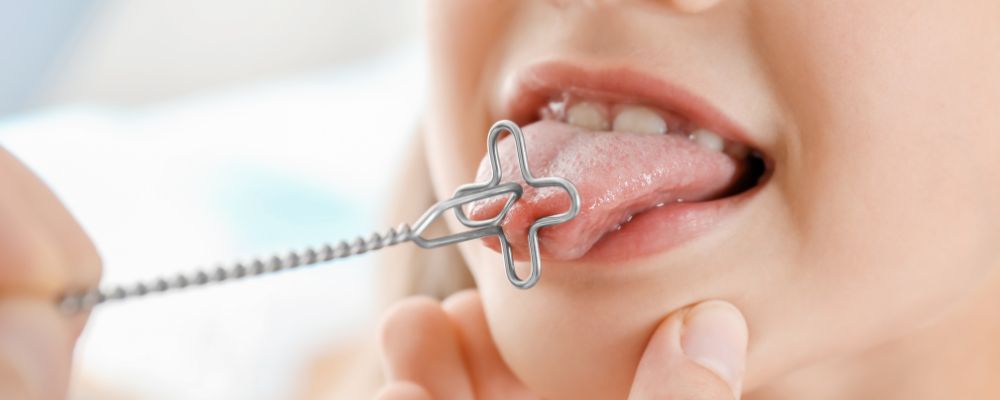It is common for parents to be unsure about the effect of a tongue tie on their child’s speech or feeding.
Many parents also wonder whether a tongue tie could be contributing to their child’s speech sound difficulties.
There are lots of factors to consider when evaluating a tongue tie and it remains a controversial area amongst professionals.

What is a tongue tie?
Ankyloglossia is the official term for a tongue tie.
“It is a condition in which the tip of the tongue cannot be protruded beyond the lower incisor teeth because of a short frenulum” (Wallace, 1963).
Currently, there are controversies around tongue tie and the classification/definition of a tongue tie.
The prevalence of tongue tie is difficult to report due to no agreed method of diagnosis or classification.
It is common for a frenectomy (surgical procedure) to be performed by dentists and doctors to snip or clip the tongue tie – usually at birth – with the idea of reducing any impacts on speech or feeding.
This is a contentious topic as there is limited evidence to support tongue ties that require surgical intervention and which are best left to observation (Suter et al., 2009)
What effects can a tongue tie have?
Tongue ties may cause difficulty with feeding in infants and oral hygiene as a child develops.
Research evidence demonstrates that tongue-tie does negatively affect breastfeeding for infants and mothers (Edmunds, Miles & Fulbrook, 2011).
For example, a baby may have difficulty breastfeeding, which can result in the baby becoming tired quickly during feeds and experiencing little or no weight gain.
Children or adults that have a tongue tie, may have difficulty eating, swallowing or clearing food from the roof of their mouth and lips.
If this is the case and your child is experiencing difficulties with any of the issues mentioned, it is important to seek advice from a qualified professional.
There may be other oro-motor difficulties affecting the child’s tongue strength, mobility or coordination, rather than a tongue tie.
A tongue tie can be identified by speech pathologists, lactation consultants, dentists, doctors, paediatricians, maxillofacial surgeons and ear nose and throat (ENT) specialists.
Does a tongue tie affect speech?
The American Speech-Language-Hearing Association (ASHA) Leader (Kummer, 2005) concluded that “there is virtually no evidence in the literature to establish a definite causal relationship between ankyloglossia [tongue tie] and speech disorders.”
A tongue tie rarely limits articulation. Many individuals with a short frenulum can still make all the sounds necessary for speech, provided their tongue tip is able to touch the alveolar ridge (behind the top front teeth).
Sounds made in this position include:
- ‘t’ as in ‘tiger’
- ‘d’ as in ‘dog’
- ‘n’ as in ‘no’
- ‘s’ as in ‘snake’
- ‘l’ as in ‘lion’
Children who are demonstrating proficient articulation of these sounds or can elevate their tongue tip to the roof of their mouth are unlikely to benefit from surgical removal of a tongue tie.

To cut or not cut the tongue tie?
A thorough assessment is required to determine if a tongue tie is negatively impacting a baby’s ability to feed. In this case, surgery can be considered.
A speech pathology assessment is essential for evaluating the impact of a tongue tie on the production of speech sounds.
In many cases, speech difficulties are unrelated to the presence of a tongue tie and surgery is not recommended.
Who can I talk to for more information?
For more information, book in to see one of our speech pathologists at Box Hill Speech Pathology!
References
Speech Pathology Australia (2023). Fact and information sheets. Retrieved from https://www.speechpathologyaustralia.org.au/SPAweb/Resources_for_the_Public/Fact_Sheets/SPAweb/Resources_for_the_Public/Fact_Sheets/Fact_Sheets.aspx?hkey=e0ad33fb-f640-45b1-8a06-11ed2b73f293
Brinkmann, S., Reilly, S., & Meara, J. G. (2004). Management of tongue‐tie in children: A survey of paediatric surgeons in Australia. Journal of paediatrics and child health, 40(11), 600-605.Edmunds, J.,
Kummer, A. W. (2005). Ankyloglossia: To Clip or Not to Clip? That’s the Question. The ASHA Leader, 10(17), 6-30.
Miles, S., & Fulbrook, P. (2011). Tongue-tie and breastfeeding: a review of the literature. Breastfeeding Review, 19(1), 19-26.
Suter, V. G., & Bornstein, M. M. (2009). Ankyloglossia: facts and myths in diagnosis and treatment. Journal of periodontology, 80(8), 1204-1219.

